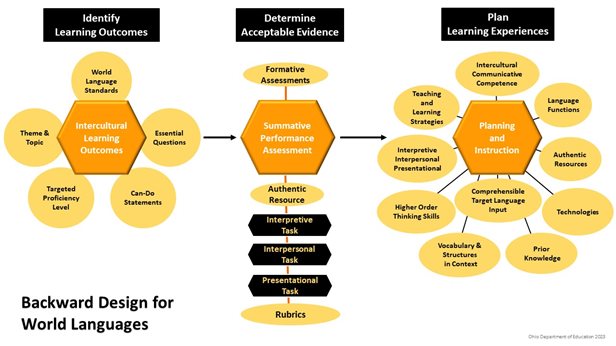Backward Design for World Languages

Download the Backward Design Image
Download Sample Intercultural Units and Planning Templates
Backward Design of Intercultural Units
Backward Design means planning instruction with the end goals in mind. This three-step framework helps educators implement a proficiency-based language program over a realistic timeline, based on the current program model. The Backward Design framework was developed by Jay McTighe and Grant Wiggins. Learn more about Backward Design.
Note that Backward Design is an integrated, non-linear process, so moving backward and forward throughout the planning process and periodic modifications are expected. The following resouces and research aim to provide clarity and support to educators in creating intercultural units, assessments and lessons that build learners' language acquisition, proficiency and intercultural competence. All curriculum design is a local decision.
How Do I Start?
STEP 1: Identify Learning Outcomes
The first step is to determine the learning outcomes or goals and what learners should know and be able to do at the end of the intercultural unit. The outcomes are framed in a real-world or authentic communicative and cultural context. The following steps can guide this process:
1. Become Familiar with Ohio's World Languages and Cultures Learning Standards
2. View Curriculum Maps Created by Ohio World Language Teachers
3. Download Ohio's Intercultural Unit Plan Template
- PDF, Word - Step-by-Step Planning Template with links and detailed explanations
- PDF, Word - Simplified Planning Template
4. View Sample Intercultural Units Across Proficiency Levels
5. Choose the Theme, Topics and Essential Questions for the Unit
An essential question is open-ended, intellectually engaging, and sparks further communication, deeper thinking and reflection on the learning outcomes of the unit.
Step 2: Determine Acceptable Evidence
The next step is to determine how learners will show evidence of meeting the learning outcomes established in Step 1. Evidence could include summative and formative assessments, homework, projects, portfolios, self-reflection, self-assessment, reports, role plays, videos, etc.
Summative assessments will be scored with
performance or proficiency rubrics. The entire assessment could be given at the end of the unit, or various components of the assessment could be given throughout the unit for time management. The following steps can guide this process:
1. Learn the Fundamentals of World Language Assessment
2. Use the Ohio Rubrics to Inform Task Design, Score Assessments and Provide Feedback
3. Design the Tasks for the Summative Performance Assessment(s)
4. Choose Authentic Cultural Materials for the Unit Assessment
Step 3: Plan Learning Experiences
The final step is to plan and scaffold activities that will help learners meet the unit goals established in Steps 1 and 2 above. By knowing in advance the learning outcomes and the assessment for the unit, the teacher can target content and activities in a more relevant and effective way. The following steps can guide this process:
1. Create Relevant Learning Experiences
-
View a sample lesson plan template from Leslie Grahn
-
Use strategies based on Universal Design for Learning principles (i.e., a variety of ways for engagement, practice and demonstration of learning).
-
Integrate a variety of activities that focus on intercultural competence; interpretive, interpersonal, presentational and literacy skills; relevant vocabulary and structures; and a variety of informal or formal formative assessment.
- Include activities to scaffold and support diverse world language learners:
2. Aim for 90%+ of Classroom Learning to Take Place in the Target Language. Read the ACTFL statement.
"Learners can only acquire (internalize) language when they hear large quantities of input that the teacher provides orally that is interesting, a little beyond students' current level of competence [ i + 1 ], and not grammatically sequenced. (Krashen, 1982). Note that the [ i ] refers to the current competence of the learner and the [ +1 ] represents the next level of competence beyond where the learner is now.
Target language use is necessary but not sufficient for increasing one’s proficiency; that is, use of the target language must be accompanied by a variety of strategies to facilitate comprehension and support meaning making. Comprehensible input and comprehensible output go hand-in-hand."
3. Find Curated High-Quality Lessons and Materials
4. Present Grammar and Vocabulary in a Meaningful Context
-
Introduce grammar or structures in a meaningful context, as chunks of language, or as a concept in order to impact language acquisition. Focus on meaning before form. Read the ACTFL research.
-
Learn about the PACE model for contextualized input.
- Review the ACTFL Performance Descriptors to set realistic expectations for what Novice, Intermediate and Advanced learners can do as far as language control/accuracy, vocabulary and communicative functions.
5. Incorporate Higher Order Thinking and Deeper Reflection Into Lessons and Activities
6. Help Learners Find Relevance in the Learning to Their Current or Future Lives
Last Modified: 4/9/2024 12:08:41 PM